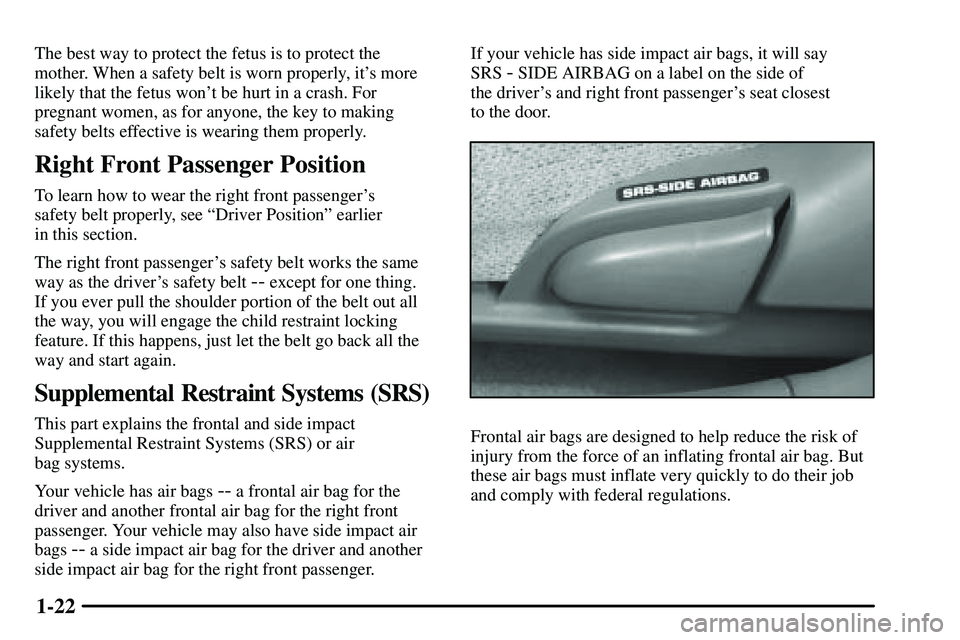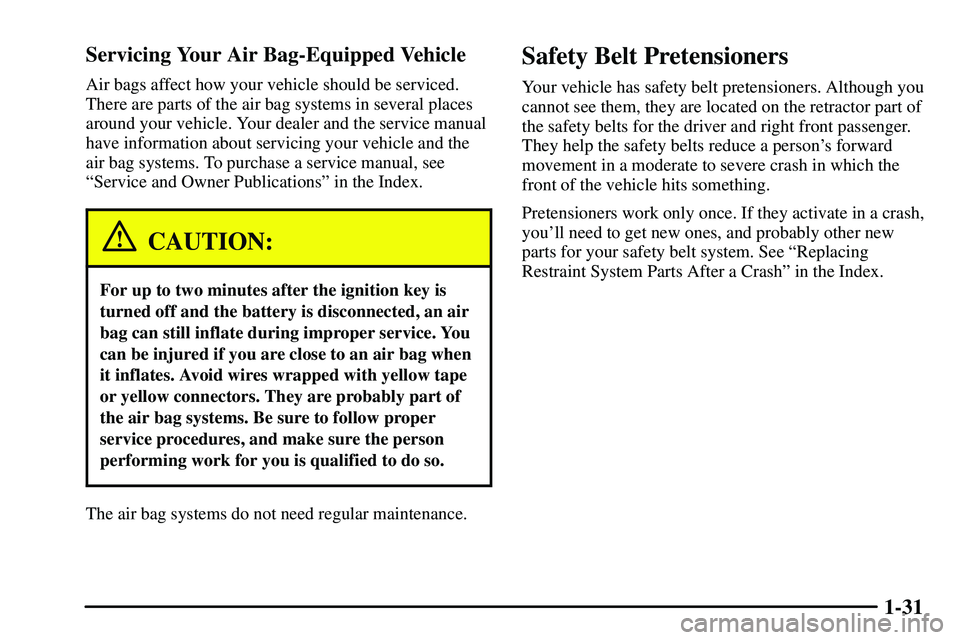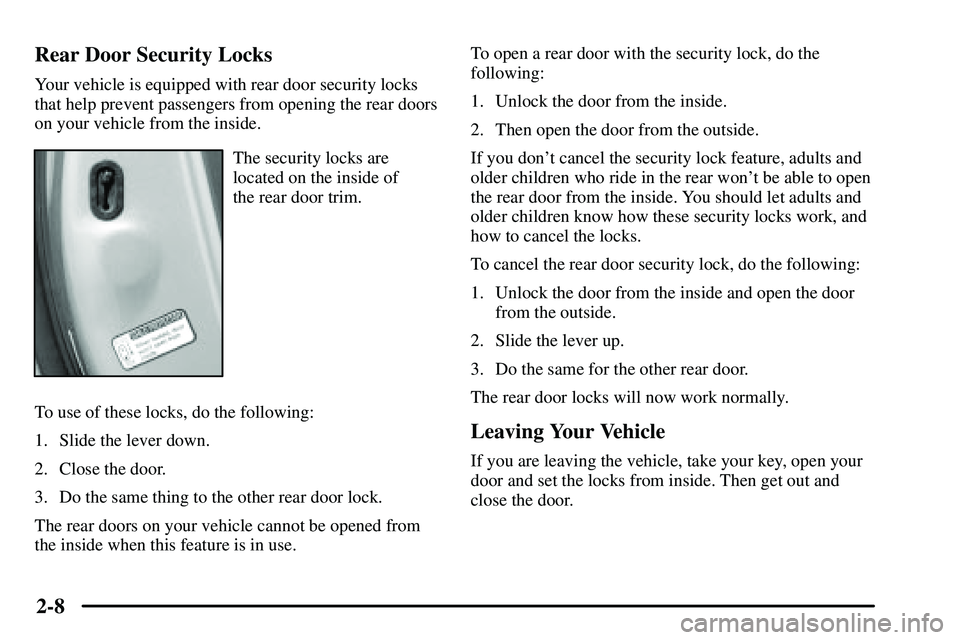Page 28 of 381

1-22
The best way to protect the fetus is to protect the
mother. When a safety belt is worn properly, it's more
likely that the fetus won't be hurt in a crash. For
pregnant women, as for anyone, the key to making
safety belts effective is wearing them properly.
Right Front Passenger Position
To learn how to wear the right front passenger's
safety belt properly, see ªDriver Positionº earlier
in this section.
The right front passenger's safety belt works the same
way as the driver's safety belt
-- except for one thing.
If you ever pull the shoulder portion of the belt out all
the way, you will engage the child restraint locking
feature. If this happens, just let the belt go back all the
way and start again.
Supplemental Restraint Systems (SRS)
This part explains the frontal and side impact
Supplemental Restraint Systems (SRS) or air
bag systems.
Your vehicle has air bags
-- a frontal air bag for the
driver and another frontal air bag for the right front
passenger. Your vehicle may also have side impact air
bags
-- a side impact air bag for the driver and another
side impact air bag for the right front passenger.If your vehicle has side impact air bags, it will say
SRS
- SIDE AIRBAG on a label on the side of
the driver's and right front passenger's seat closest
to the door.
Frontal air bags are designed to help reduce the risk of
injury from the force of an inflating frontal air bag. But
these air bags must inflate very quickly to do their job
and comply with federal regulations.
Page 37 of 381

1-31 Servicing Your Air Bag-Equipped Vehicle
Air bags affect how your vehicle should be serviced.
There are parts of the air bag systems in several places
around your vehicle. Your dealer and the service manual
have information about servicing your vehicle and the
air bag systems. To purchase a service manual, see
ªService and Owner Publicationsº in the Index.
CAUTION:
For up to two minutes after the ignition key is
turned off and the battery is disconnected, an air
bag can still inflate during improper service. You
can be injured if you are close to an air bag when
it inflates. Avoid wires wrapped with yellow tape
or yellow connectors. They are probably part of
the air bag systems. Be sure to follow proper
service procedures, and make sure the person
performing work for you is qualified to do so.
The air bag systems do not need regular maintenance.
Safety Belt Pretensioners
Your vehicle has safety belt pretensioners. Although you
cannot see them, they are located on the retractor part of
the safety belts for the driver and right front passenger.
They help the safety belts reduce a person's forward
movement in a moderate to severe crash in which the
front of the vehicle hits something.
Pretensioners work only once. If they activate in a crash,
you'll need to get new ones, and probably other new
parts for your safety belt system. See ªReplacing
Restraint System Parts After a Crashº in the Index.
Page 65 of 381

2-
2-1
Section 2 Features and Controls
Here you can learn about the many standard and optional features on your vehicle, and information on starting,
shifting and braking. Also explained are the instrument panel and the warning systems that tell you if everything is
working properly
-- and what to do if you have a problem.
2
-2 Windows
2
-4 Keys
2
-6 Door Locks
2
-9 Remote Keyless Entry System (If Equipped)
2
-12 Liftgate/Liftglass
2
-14 Theft
2
-17 New Vehicle ªBreak-Inº
2
-18 Ignition Positions
2
-19 Starting Your Engine
2
-21 Engine Coolant Heater (If Equipped)
2
-22 Automatic Transaxle Operation
2
-25 Manual Transaxle Operation
2
-29 Parking Brake
2
-30 Shifting Into PARK (P)
(Automatic Transaxle Only)
2
-32 Shifting Out of PARK (P)
(Automatic Transaxle Only)
2
-33 Parking Your Vehicle
(Manual Transaxle Only)
2
-33 Parking Over Things That Burn2
-34 Engine Exhaust
2
-34 Running Your Engine While You're Parked
(Automatic Transaxle)
2
-35 Horn
2
-35 Tilt Wheel
2
-36 Turn Signal/Multifunction Lever
2
-38 Windshield Washer
2
-39 Cruise Control (Option)
2
-42 Exterior Lamps
2
-44 Interior Lamps
2
-46 Mirrors
2
-48 Storage Compartments
2
-53 Ashtrays and Cigarette Lighter
2
-53 Sun Visors
2
-57 Sunroof (Option)
2
-58 The Instrument Panel -- Your
Information System
2
-60 Instrument Panel Cluster
2
-62 Warning Lights, Gages and Indicators
2
-76 Navigation System (Option)
Page 68 of 381
2-4
Keys
CAUTION:
Leaving children in a vehicle with the ignition
key is dangerous for many reasons. A child or
others could be badly injured or even killed.
They could operate the power windows or other
controls or even make the vehicle move. Don't
leave the keys in a vehicle with children.
Page 69 of 381
2-5
One key is used for the
ignition, the doors and all
other locks.
When a new vehicle is delivered, the dealer removes the
key tag from the key and gives it to the first owner.
Each tag has a code on it that tells your dealer or a
qualified locksmith how to make extra keys. Keep the
tag in a safe place. If you lose your key, you'll be able to
have a new one made easily using this code.
If you need a new key, contact your dealership to obtain
the correct key code. See ªRoadside Assistanceº in the
Index for more information.
NOTICE:
Your vehicle has a number of features that can
help prevent theft. However, you can have a lot of
trouble getting into your vehicle if you ever lock
your key inside. You may even have to damage
your vehicle to get in. So be sure you have an
extra key.
Page 70 of 381
2-6
Door Locks
CAUTION:
Unlocked doors can be dangerous.
�Passengers -- especially children -- can
easily open the doors and fall out of a
moving vehicle. When a door is locked, the
handle won't open it. You increase the
chance of being thrown out of the vehicle in
a crash if the doors aren't locked. So, wear
safety belts properly and lock the doors
whenever you drive.
�Young children who get into unlocked
vehicles may be unable to get out. A child
can be overcome by extreme heat and can
suffer permanent injuries or even death
from heat stroke. Always lock your vehicle
whenever you leave it.
�Outsiders can easily enter through an
unlocked door when you slow down or stop
your vehicle. Locking your doors can help
prevent this from happening.
There are several ways to lock and unlock your vehicle.
From the outside, use your key or the remote keyless
entry transmitter, if equipped. See ªRemote Keyless
Entryº in the Index for more information.
Page 71 of 381
2-7
To manually lock the door from the inside, press the
knob on the door forward. To unlock the door, press the
knob rearward. If you have manual locks, you must use
the key to lock and unlock the tailgate.
If your vehicle has power door locks, open the driver's
door by turning the key in the lock toward the rear of the
vehicle. Turning the key back toward the center, then
toward the rear again will unlock all of the doors. Using
the key in the passenger's door will also unlock all of
the doors.
Lock a door by turning the key toward the front of
the vehicle. If you have power door locks, all the
doors will lock.Power Door Locks (Option)
The power door lock switch
is located on the armrest on
the door.
Press the power door lock switch on the driver's or
passenger's door to lock or unlock all the doors at once.
Page 72 of 381

2-8 Rear Door Security Locks
Your vehicle is equipped with rear door security locks
that help prevent passengers from opening the rear doors
on your vehicle from the inside.
The security locks are
located on the inside of
the rear door trim.
To use of these locks, do the following:
1. Slide the lever down.
2. Close the door.
3. Do the same thing to the other rear door lock.
The rear doors on your vehicle cannot be opened from
the inside when this feature is in use.To open a rear door with the security lock, do the
following:
1. Unlock the door from the inside.
2. Then open the door from the outside.
If you don't cancel the security lock feature, adults and
older children who ride in the rear won't be able to open
the rear door from the inside. You should let adults and
older children know how these security locks work, and
how to cancel the locks.
To cancel the rear door security lock, do the following:
1. Unlock the door from the inside and open the door
from the outside.
2. Slide the lever up.
3. Do the same for the other rear door.
The rear door locks will now work normally.
Leaving Your Vehicle
If you are leaving the vehicle, take your key, open your
door and set the locks from inside. Then get out and
close the door.